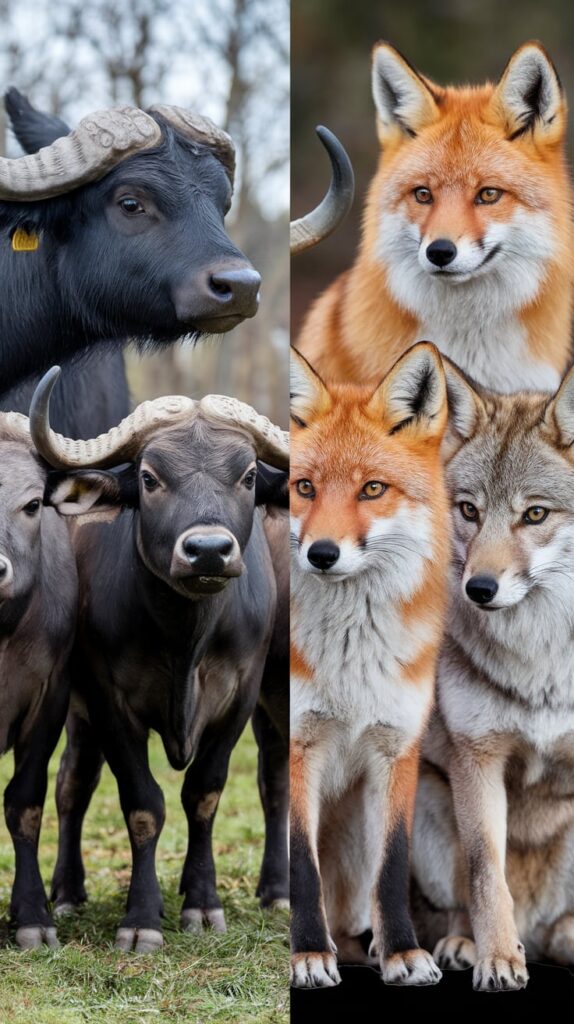Understanding the plurals of ‘ox’ and ‘fox’ offers a captivating look into the nuances of the English language. This exploration helps us answer the question, What Are the Plurals of ‘Ox’ and ‘Fox’?
As we delve deeper, we’ll cover not only the plural forms “oxen” and “foxes” but also their possessive uses, cultural significance, and more. This comprehensive article will be structured with rich examples and detailed explanations to ensure clarity and engagement.
Read more : “Totalling” vs. “Totaling”: Navigating the Spelling Dilemma – Grammar Beacon
Singular Forms: Ox and Fox
To lay a strong foundation, let’s first look closely at the singular forms of these words.
Ox
The term “ox” refers to a large, domesticated bovine, often trained for draft work. Oxen have been pivotal in agriculture, used for plowing fields, transporting goods, and even as a source of meat and leather.

Historical Context: The word “ox” comes from the Old English word “oxa,” which has cognates in various Germanic languages. This historical perspective highlights the ox’s long-standing importance in human civilization.
read more : Other Ways to Say Thank You For Responding Quickly – Grammar Beacon
Cultural Representation: In many cultures, oxen symbolize strength, perseverance, and hard work. They frequently appear in folklore and agricultural practices.
Fox
On the other hand, “fox” denotes a small to medium-sized carnivorous mammal known for its cunning nature. Foxes are characterized by their pointed snouts, bushy tails, and agile bodies.
Historical Context: The word “fox” comes from the Old English “fox,” with roots in Proto-Germanic and other ancient languages. This linguistic lineage reflects the animal’s longstanding presence in folklore and culture.
Cultural Representation: Foxes often symbolize cleverness and trickery. They appear in fables, stories, and even as mascots in various contexts, highlighting their association with intelligence and adaptability.
read more : Other Ways to Say Thank You for Your Attention – Grammar Beacon

Plural Forms: Oxen and Foxes
Oxen
The plural of “ox” is “oxen.” This form retains the Old English pluralization pattern, where some nouns take an -en suffix instead of the more common -s or -es.
Etymological Roots: The -en plural form reflects a historical method of forming plurals in English, indicating a more archaic grammatical structure. This form persists in a few other nouns as well, such as “children” and “men.”
Usage in Sentences:
Correct: The farmer’s oxen worked tirelessly in the fields.
Incorrect: The farmer’s oxs worked tirelessly in the fields.
Foxes
In contrast, the plural of “fox” is “foxes.” This plural follows the standard rule of adding -es to nouns ending in -x.
Etymological Roots: This pluralization reflects a more modern approach to forming plurals, making it easier for learners of English to grasp. The pattern of adding -es is prevalent among nouns ending in consonants.
read more : Story’s or Stories possessives – Grammar Beacon
Usage in Sentences:
Correct: The foxes darted through the underbrush.
Incorrect: The foxes darted through the underbrush.
Comparing Plurals
When we examine “oxen” and “foxes,” we uncover significant differences in their formation, usage, and underlying grammar rules.
Why ‘Foxes’ for ‘Fox’ and ‘Oxen’ for ‘Ox’?
The distinct plural forms of “ox” and “fox” illustrate the evolution of English and its varied influences.
Historical Influence:
“Oxen” stems from a time when Old English was more commonly used, showcasing the remnants of an earlier linguistic system that relied on different methods for pluralization.
“Foxes,” however, fits neatly into the modern conventions that simplify pluralization, reflecting the language’s adaptation over time.
Practicality: The simplicity of using -es for plurals like “foxes” aids in language learning, while the unique form of “oxen” provides an opportunity to engage with historical aspects of English.
read more : Student’s, Students’, or Students? – Grammar Beacon

Possessive Forms
Possessive of Oxen
Understanding possessive forms enriches our grasp of these nouns. Here’s a detailed look at their possessive uses:
Singular Possessive:
Example: The ox’s yoke was heavy.
Meaning: Indicates that a single ox owns the yoke.
Plural Possessive:
Example: The oxen’s pasture was lush.
Meaning: Indicates that the pasture belongs to multiple oxen.
Complex Possessive Use:
Example: The farmer adjusted the ox’s harness before leading the oxen into the field.
Meaning: This illustrates both singular and plural possessive forms working together in context.
Possessive of Foxes
Similarly, let’s explore the possessive forms for foxes:
Singular Possessive:
Example: The fox’s den was hidden in the brush.
Meaning: Indicates ownership of the den by one fox.
Plural Possessive:
Example: The foxes’ fur glistened in the sunlight.
Meaning: Indicates that the fur belongs to several foxes.
Complex Possessive Use:
Example: The fox’s cleverness helped it evade the trap, while the foxes’ family remained safe.
Meaning: Both forms enhance the narrative, providing a richer context.
Summary of Possessives
| Type | Singular Form | Plural Form | Possessive (Singular) | Possessive (Plural) |
| Ox | Ox | Oxen | Ox’s | Oxen’s |
| Fox | Fox | Foxes | Fox’s | Foxes’ |
Scenario Examples
Scenario 1: A Day on the Farm
Imagine visiting a picturesque farm. The air is filled with the scent of fresh hay, and the sounds of nature surround you. As you approach the barn, you spot a strong ox working diligently in the fields.
The farmer, with a friendly smile, explains, “That’s the ox’s favorite yoke. It fits him just right.” You observe the ox’s muscular frame and appreciate its hard work.
Later, as you walk through the sprawling fields, the farmer points to a vast area of lush grass. “This is where my oxen graze,” he says. You watch as the oxen munch contentedly on the green grass, their robust bodies thriving in the open space.

Scenario 2: The Fox Family in the Forest
Now, picture a serene forest, where sunlight filters through the leaves. As you stroll along a narrow path, you catch sight of a clever fox peeking out from behind a tree.
You think, “Look at the fox’s watchfulness! It’s so aware of its surroundings.” Just as you admire its grace, the fox dashes away, blending seamlessly into the forest.
Continuing your walk, you hear a commotion nearby. Curious, you venture closer and discover a playful group of foxes tumbling and playing in a small clearing. “Those are the foxes’ playful antics!” you exclaim, captivated by their energy and camaraderie.
The Importance of Context
Language is not just about rules and vocabulary; it is also about context. Understanding the cultural significance of words enhances our appreciation of them.
Cultural Significance of the Ox
In various cultures, the ox represents:
- Strength and Hard Work: Often depicted as a symbol of labor, particularly in agrarian societies.
- Fertility and Prosperity: In some cultures, oxen are associated with agricultural success, symbolizing abundance and prosperity.
Cultural Significance of the Fox
Conversely, the fox is often associated with:
- Cunning and Trickery: In many stories, the fox is portrayed as a clever character that uses its wits to overcome challenges.
- Adaptability: Foxes thrive in diverse environments, symbolizing resilience and resourcefulness.
Exploring Irregular Plurals
English features a number of irregular plural forms that can be puzzling for learners. Understanding these can enrich your vocabulary.
Other Irregular Plurals
| Singular | Plural | Possessive (Singular) | Possessive (Plural) |
| Child | Children | Child’s | Children’s |
| Person | People | Person’s | People’s |
| Mouse | Mice | Mouse’s | Mice’s |
These examples showcase the diversity and complexity of English plurals. Each of these words has unique rules, making it essential for learners to engage with them contextually.

The Role of Grammar in Language Learning
Understanding the grammatical rules surrounding plurals and possessives is crucial for mastering English. Here are key points to remember:
Historical Context: Learning the history of words like “ox” and “fox” helps in understanding their forms. Etymology provides insights into the evolution of language.
Practical Application: Using these words in sentences reinforces their meanings. Creating scenarios, as illustrated, allows for practical application of grammar rules.
Engagement with Language: Actively engaging with language through reading, writing, and conversation enhances familiarity with grammar rules. Real-life examples make the learning process enjoyable.
Enhancing Vocabulary with Contextual Learning
Vocabulary expansion thrives in context. To build a robust vocabulary around “ox” and “fox,” consider exploring related terms and phrases.
Related Vocabulary for Ox
- Cattle: A broader term that includes domesticated bovines like oxen.
- Yoke: A harness used to connect oxen for pulling heavy loads.
- Draft Animal: An animal trained to perform tasks such as pulling carts or plows.
Related Vocabulary for Fox
- Den: The home or burrow of a fox.
- Cunning: The quality of being clever or sly, often used to describe the nature of a fox.
- Wildlife: Refers to all living organisms, including foxes, in their natural environment.
The Power of Storytelling in Learning
Storytelling is a powerful tool for language learning. By weaving narratives around words, you create memorable associations.
Example Story
Once upon a time, in a lush green valley, a hardworking ox named Otto toiled alongside his fellow oxen. They plowed fields and carried heavy loads for the kind farmer.
Otto took great pride in his work, wearing his ox’s yoke with honor.
One day, while resting, Otto overheard whispers from the nearby forest. A clever fox named Fiona was sharing tales of her adventures with her foxes family. Fiona had outsmarted hunters and found the best hiding spots, earning her the respect of all.
Otto, intrigued by Fiona’s cunning, decided to pay her a visit. He shared stories of the oxen’s strength and the farmer’s gratitude. As the two exchanged stories, a friendship blossomed, showing that even the mightiest of oxen could learn from the cleverness of a fox.
Conclusion
Exploring the plurals of ‘ox’ and ‘fox’ not only enriches your vocabulary but also deepens your understanding of the English language. The unique plural forms—“oxen” and “foxes”—highlight the fascinating historical and grammatical evolution of English.

By grasping possessive forms and contextual usage, you can enhance your communication skills. Understanding the cultural significance of these words adds another layer of richness to your language journey.
Keep engaging with language, and you’ll discover that mastering English is a rewarding adventure filled with stories, nuances, and endless possibilities.
Summary Table of Key Concepts
| Concept | Singular Form | Plural Form | Possessive (Singular) | Possessive (Plural) |
| Ox | Ox | Oxen | Ox’s | Oxen’s |
| Fox | Fox | Foxes | Fox’s | Foxes’ |
| Other Irregulars | Child | Children | Child’s | Children’s |
| Person | People | Person’s | People’s | |
| Mouse | Mice | Mouse’s | Mice’s |
Through this comprehensive exploration of “ox” and “fox,” we’ve uncovered not just their plural forms but also their rich narratives, cultural significance, and the complexities of English grammar.
Whether you’re a language learner or simply curious about the intricacies of English, understanding these elements enhances your appreciation of the language. Keep exploring, keep learning, and enjoy the journey!

James Logan is a seasoned blogger and language enthusiast behind Grammar Beacon. With years of experience in grammar and writing, James shares his expertise through insightful and engaging content. His passion for clear communication and linguistic precision shines in every post, making complex grammar concepts accessible and enjoyable for readers. Follow James for expert advice and tips to refine your writing skills.






